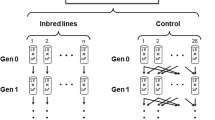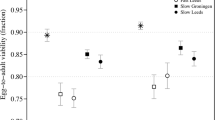Abstract
RECENT development in population genetics indicate that it is often misleading to treat selective values as constants1–5. These studies indicate that selective forces may be a function of genotype frequencies (frequency-dependent selection). For example, if the rarest genotype is most fit then the rare allele will increase in frequency but will not become fixed in the population, because as it gets more common the fitness of its carriers decreases. This mechanism is attractive since it leads to a stable gene frequency equilibrium which may not involve problems of genetic load or inbreeding depression. Experimental evidence has been obtained6,7 which supports the view that frequency dependence is involved in the maintenance of the esterase-6 (Est-6) and alcohol dehydrogenase (Adh) loci in Drosophila melanogaster. However, these results are subject to two major criticisms8–11. First, the observed frequency dependence may have resulted from poor experimental design. In the original report6 fitness estimates were made by comparisons of adult frequencies with those expected from the gene frequencies in the previous generation. Frequency-dependent selection appears as an artefact of this method12. Second, since inbred lines were used in these studies problems of linkage disequilibrium may have occurred. If this view is correct then the observed selective differences were due to differences between lines, not to differences between alleles at a locus. As a consequence of these criticisms the role of frequency dependence as a force responsible for maintaining enzyme polymorphism has been disputed9. The experiments reported here overcome these criticisms and indicate that frequency-dependent selection should be reconsidered as an important mechanism involved in the maintenance of enzyme polymorphism.
This is a preview of subscription content, access via your institution
Access options
Subscribe to this journal
Receive 51 print issues and online access
$199.00 per year
only $3.90 per issue
Buy this article
- Purchase on Springer Link
- Instant access to full article PDF
Prices may be subject to local taxes which are calculated during checkout
Similar content being viewed by others
References
Moment, G. B., Science, 136, 1055–1056 (1962).
Allen, J. A., and Clarke, B., Nature, 220, 501–502 (1968).
Levin, D. A., Am. Nat., 106, 453–460 (1972).
Nassar, R., Muhs, H. J., and Cook, R. D., Evolution, 27, 558–564 (1973).
Clarke, B., in The Role of Natural Selection in Human Evolution (edit. by Salzano, F. M.) 187–200 (North-Holland, Amsterdam, 1975).
Kojima, K., and Yarbrough, K. M., Proc. natn. Acad. Sci. U.S.A., 57, 645–649 (1967).
Kojima, K., and Tobari, Y., Genetics, 61, 201–209 (1969).
Yamazaki, T., Genetics, 67, 579–603 (1971).
Lewontin, R. C., A. Rev. Genet., 7, 1–17 (1973); The Genetic Basis of Evolutionary Change (Columbia University Press, New York, 1974).
Dolan, R., thesis, Edinburgh Univ. (1974).
Dolan, R., and Robertson, A., Heredity, 35, 311–316 (1975).
Prout, T., Evolution, 19, 546–551 (1965).
O'Brien, S. J., and MacIntyre, R. J., Am. Nat., 103, 97–113 (1969).
Day, T. H., Hillier, P. C., and Clarke, B., Biochem. Genet., 11, 141–153 (1974).
Briscoe, D. A., thesis, Edinburgh Univ. (1973).
Author information
Authors and Affiliations
Rights and permissions
About this article
Cite this article
MORGAN, P. Frequency-dependent selection at two enzyme loci in Drosophila melanogaster. Nature 263, 765–766 (1976). https://doi.org/10.1038/263765a0
Received:
Accepted:
Issue Date:
DOI: https://doi.org/10.1038/263765a0
This article is cited by
-
Associations of esterase 6 allozyme and activity variation with reproductive fitness inDrosophila melanogaster
Genetica (1994)
-
Changes in gene frequencies at the octanol dehydrogenase locus of Drosophila melanogaster imposed by environmental ethanol
Genetica (1988)
-
Selection in highly inbred populations of Drosophila melanogaster polymorphic at a single locus
Heredity (1985)
-
Est-6 in Drosophila melanogaster: effects of genetic composition, temperature and oviposition period on fitness in laboratory populations polymorphic for rare alleles
Heredity (1985)
-
A bias in estimation of viabilities from competition experiments
Heredity (1982)
Comments
By submitting a comment you agree to abide by our Terms and Community Guidelines. If you find something abusive or that does not comply with our terms or guidelines please flag it as inappropriate.



